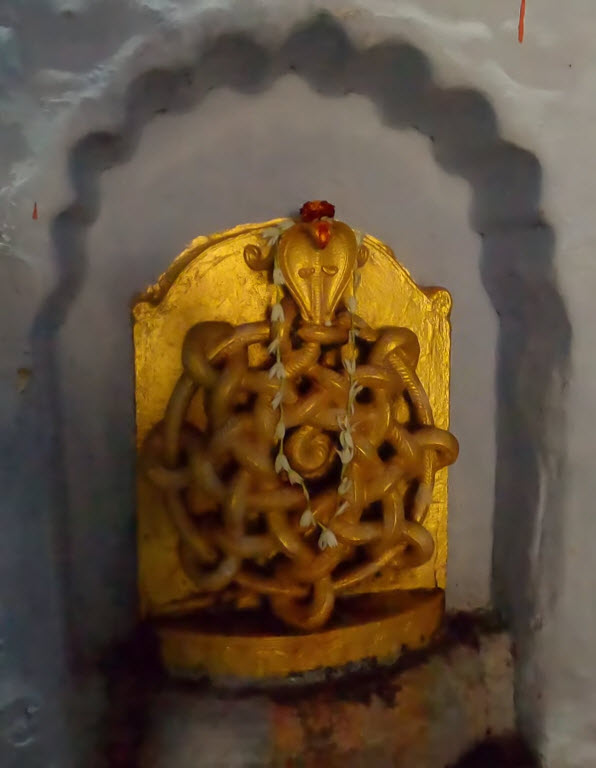Vasuki, the king of the Nagas in Hindu History

Vasuki, the king of the Nagas in Hindu mythology, is a figure rich in mythological and cultural significance. Here are some rare and interesting pieces of information about Vasuki and its idols:
## Mythological Significance
– Vasuki is one of the sons of the sage Kashyapa and Kadru, and he is known for his significant role in the legend of Samudra Manthana, where he was used as a rope by the devas and asuras to churn the Ocean of Milk to extract the amrita.
– He is often depicted coiling around the neck of Lord Shiva, symbolizing his cosmic energy and his role as an ornament for Shiva.
##Iconography and Idols
– In Hindu iconography, Vasuki is typically depicted with a gem called Nagamani on his head. This gem is considered highly valuable and symbolic of his status as the king of the Nagas.
– At the Temple of Vasuki Nag in Panealagh, Bani, in the Kathua district, there are black-stone statues of Vasuki and his benefactor, Jimut Vahan. These statues are about six feet tall and are placed on an elaborately carved pedestal. The story behind these idols involves Raja Bhupat Pal of Basohli, who promised to build a temple for Vasuki Nag after an encounter with the serpent king.
## Magical Powers and Associations
– Vasuki is said to possess magical powers, including the ability to assume various forms (iccha-dhari Naga) and to impart magical spells to worthy recipients. This has led to his veneration and awe in Hindu mythology.
– He is also associated with the netherworld, known as Naga-loka or Patala-loka, where he rules along with other powerful serpents like Śankha, Kulika, and others.
## Regional Legends and Temples
– The temple dedicated to Vasuki Nag in Panealagh was built after the idols were mysteriously halted there during their transport from Bhadarwah to Basohli. The chief priest advised building the temple at Panealagh, as Vasuki Nag did not want to proceed to Basohli.
– There are other temples dedicated to Vasuki, such as the Vāsuka/Vāsuca temple near Haripad in Kerala and the Visakha district in Andhra Pradesh.
## Cross-Cultural Significance
– Vasuki is not only significant in Hinduism but also appears in Buddhist mythology, where he and other Naga Kings are involved in protecting and worshipping the Buddha.
– In Chinese and Japanese mythology, Vasuki is one of the “eight Great Dragon Kings”.
## Scientific and Historical Context
– Interestingly, a prehistoric snake discovered in India has been named Vasuki indicus, drawing a scientific parallel to the mythological figure. This snake, estimated to be around 11 to 15 meters long, lived during the Eocene period and is considered one of the largest snakes to have ever existed.
These aspects highlight the multifaceted nature of Vasuki, both as a mythological figure and as a symbol deeply embedded in various cultural and religious traditions.
———————————————————
Vasuki, the serpent king in Hindu mythology, is a figure rich in mythological and cultural significance. Here are some rare and interesting pieces of information about Vasuki and its idols:
## Mythological Significance
– Vasuki is the king of the Nagas and is often depicted coiled around the neck of Lord Shiva. He is revered for his strength and endurance, as evidenced by his role in the Samudra Manthan, where he was used as a rope to churn the Ocean of Milk to extract the elixir of life, Amrita.
– He is the son of Kadru and Kashyapa, and his siblings include other notable Nagas like Shesha and Manasa.
## Magical and Protective Attributes
– Vasuki is said to possess a gem called Nagamani on his head, which is highly valued and symbolic of his status as the serpent king. He is also associated with magical powers, including the ability to assume various forms and impart magical spells to worthy recipients.
– In Hindu mythology, Vasuki and other Nagas are often depicted as guardians of hidden treasures and possessors of priceless magical gems and other objects of wealth.
## Temples and Idols
– There is a notable temple dedicated to Vasuki in Panealagh, in the Kathua district of Jammu and Kashmir. According to local legend, Raja Bhupat Pal of Basohli built this temple after encountering Vasuki in Kailash Kund. The temple features life-like black-stone statues of Vasuki and his benefactor, Jimut Vahan, which were carved by sculptors from Bhadarwah.
– The Vāsuka/Vāsuca temple near Haripad in Kerala is another significant site associated with Vasuki worship. This temple reflects the regional veneration of Vasuki and other Naga deities.
## Cultural and Iconographic Significance
– Vasuki is also significant in Buddhist mythology, where he and other Naga Kings are depicted as protectors and worshippers of the Buddha. They play a crucial role in leading the Nagas in protecting enlightened beings.
– In iconography, Vasuki is often shown with a half-Swastika (Svastika-ardha) on the back of his hood, which is considered an auspicious symbol.
## Fossil Discovery
– Interestingly, a 47 million-year-old fossil of a massive snake was discovered in a Gujarat coal mine and named Vasuki indicus. This prehistoric snake is believed to be one of the longest to have ever existed, possibly even longer than a Tyrannosaurus Rex. The discovery bridges the gap between mythological and scientific significance of the name Vasuki.
These aspects highlight the multifaceted role of Vasuki in Hindu mythology and culture, as well as the enduring impact of his legend across various fields.
